Dibyajyoti Sarma's Blog, page 34
August 31, 2015
Twelve Years a Slave (1853) is a memoir and slave narrati...
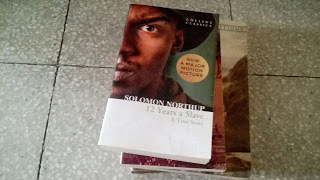 Twelve Years a Slave (1853) is a memoir and slave narrative by American Solomon Northup as told to and edited by David Wilson. Northup, a black man who was born free in New York state, details his being tricked to go to Washington, D.C., where he was kidnapped and sold into slavery in the Deep South. After having been kept in bondage for 12 years in Louisiana by various masters, Northup was able to write to friends and family in New York, who in turn secured his release with the aid of the state. Northup's account provides extensive details on the slave markets in Washington, D.C. and New Orleans, and describes at length cotton and sugar cultivation and slave treatment on major plantations in Louisiana.
Twelve Years a Slave (1853) is a memoir and slave narrative by American Solomon Northup as told to and edited by David Wilson. Northup, a black man who was born free in New York state, details his being tricked to go to Washington, D.C., where he was kidnapped and sold into slavery in the Deep South. After having been kept in bondage for 12 years in Louisiana by various masters, Northup was able to write to friends and family in New York, who in turn secured his release with the aid of the state. Northup's account provides extensive details on the slave markets in Washington, D.C. and New Orleans, and describes at length cotton and sugar cultivation and slave treatment on major plantations in Louisiana.The work was published eight years before the Civil War by Derby & Miller of Auburn, New York, soon after Harriet Beecher Stowe's best-selling novel about slavery, Uncle Tom's Cabin (1852), to which it lent factual support. Northup's book, dedicated to Stowe, sold 30,000 copies, making it a bestseller in its own right.
After being published in several editions in the 19th century and later cited by specialist scholarly works on slavery in the United States, the memoir fell into public obscurity for nearly 100 years. It was re-discovered on separate occasions by two Louisiana historians, Sue Eakin (Louisiana State University at Alexandria) and Joseph Logsdon (University of New Orleans). In the early 1960s, they researched and retraced Solomon Northup’s journey and co-edited a historically annotated version that was published by Louisiana State University Press (1968).
The memoir has been adapted as two film versions, produced as the PBS television movie Solomon Northup's Odyssey (1984) and the Oscar-winning film 12 Years a Slave (2013).
More here/
Published on August 31, 2015 04:03
The Talisman Ring is a historical romance novel by George...
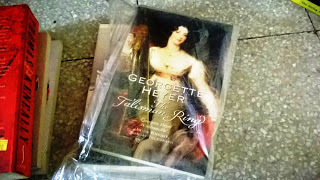 The Talisman Ring is a historical romance novel by Georgette Heyer, first published in 1936. Set in 1793, in the Georgian era, the action takes place in Sussex, where Heyer then lived.
The Talisman Ring is a historical romance novel by Georgette Heyer, first published in 1936. Set in 1793, in the Georgian era, the action takes place in Sussex, where Heyer then lived.Like several of Heyer's early novels including Regency Buck (1935) and The Corinthian (1940), The Talisman Ring blends the genres of romantic comedy and thriller. Jane Aiken Hodge describes it as a "neat comedy"[4] and "very nearly a detective story in period costume". In counterpointing an older and a younger couple, the novel is a forerunner of many of Heyer's later works, such as Frederica (1965). The Talisman Ring is also the first of Heyer's novels to feature characters from the Bow Street Runners.
More here/
/
Georgette Heyer /ˈheɪ.ər/ (16 August 1902 – 4 July 1974) was an English historical romance and detective fiction novelist. Her writing career began in 1921, when she turned a story for her younger brother into the novel The Black Moth. In 1925 Heyer married George Ronald Rougier, a mining engineer. The couple spent several years living in Tanganyika Territory and Macedonia before returning to England in 1929. After her novel These Old Shades became popular despite its release during the General Strike, Heyer determined that publicity was not necessary for good sales. For the rest of her life, she refused to grant interviews, telling a friend: "My private life concerns no one but myself and my family."
Heyer essentially established the historical romance genre and its subgenre Regency romance. Her Regencies were inspired by Jane Austen, but unlike Austen, who wrote about and for the times in which she lived, Heyer was forced to include copious information about the period so that her readers would understand the setting. To ensure accuracy, Heyer collected reference works and kept detailed notes on all aspects of Regency life. While some critics thought the novels were too detailed, others considered the level of detail to be Heyer's greatest asset. Her meticulous nature was also evident in her historical novels; Heyer even recreated William the Conqueror's crossing into England for her novel The Conqueror.
Beginning in 1932, Heyer released one romance novel and one thriller each year. Her husband often provided basic outlines for the plots of her thrillers, leaving Heyer to develop character relationships and dialogue so as to bring the story to life. Although many critics describe Heyer's detective novels as unoriginal, others such as Nancy Wingate praise them "for their wit and comedy as well as for their well-woven plots".
Her success was sometimes clouded by problems with tax inspectors and alleged plagiarists. Heyer chose not to file lawsuits against the suspected literary thieves, but tried multiple ways of minimizing her tax liability. Forced to put aside the works she called her "magnum opus" (a trilogy covering the House of Lancaster) to write more commercially successful works, Heyer eventually created a limited liability company to administer the rights to her novels. She was accused several times of providing an overly large salary for herself, and in 1966 she sold the company and the rights to seventeen of her novels to Booker-McConnell. Heyer continued writing until her death in July 1974. At that time, 48 of her novels were still in print; her last book, My Lord John, was published posthumously.
More here/
Published on August 31, 2015 03:57
“A God can get tired too.”In Aleksei German’s art house, ...
 “A God can get tired too.”
“A God can get tired too.”In Aleksei German’s art house, hard to watch Russian film, ‘Hard to Be a God.
Published on August 31, 2015 03:56
Above the clouds, above Guwahati. I clicked this photo du...
 Above the clouds, above Guwahati.
Above the clouds, above Guwahati. I clicked this photo during a flight from Delhi to Guwahati. It was monsoon reason, yet that day, the sky was clear and the clouds were fluffy white. And it was a completely weird feeling regarding the clouds from above. Normally, I would look at the cloud from below. This time I had a vantage point.
And it was a gaze that could make you feel profoundly lonely and profoundly insignificant.
As I mulled over the meaning of life looking at the clouds and thinking, what will happen, right now, if the flight lost its control and went down, and then, without any warning, I was humming this silly song from that silly movie called Khel (1992), ‘…naa hai zameen naa aasman, laye kaha ho hamko… badal nagar hai meraa ghar, laya jahan hu tumko …”
An anticlimax!
Published on August 31, 2015 03:44
The guava tree outside our house. The guava tree has a sp...
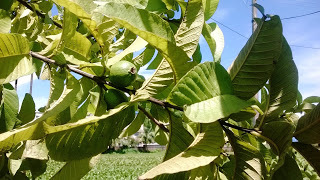 The guava tree outside our house.
The guava tree outside our house. The guava tree has a special place in our family. My father had a transferable job and during our childhood, we travelled from city to city, from house to house and for some reason, in every house, there will be a guava tree. When, after his retirement, my father built this house in Lankeshwar, Guwahati, the first tree that grew near the gate was a guava tree, laden with those marvellous green fruits with pink-red kernels.
Published on August 31, 2015 03:31
A staple of Assamese homes, the godhuli gopal flower, cal...
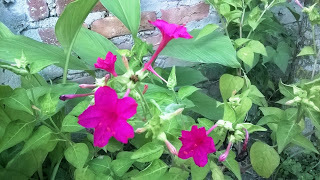 A staple of Assamese homes, the godhuli gopal flower, called so because it blooms only in the evening, after the sun has waned. Godhuli is evening and gopal is baby Krishna.
A staple of Assamese homes, the godhuli gopal flower, called so because it blooms only in the evening, after the sun has waned. Godhuli is evening and gopal is baby Krishna.Mirabilis jalapa (the four o'clock flower or marvel of Peru) is the most commonly grown ornamental species of Mirabilis, and is available in a range of colours. Mirabilis in Latin means wonderful and Jalapa is a not uncommon place name in Central and North America. Mirabilis jalapa is said to have been exported from the Peruvian Andes in 1540.
In Pakistan it is called gul adnan (Urdu: گل عدنان), gul-e-abbas (Urdu: گل عباس).
In Sri Lanka it is called hendirikka (හෙන්දිරික්කා).
In Karnataka it is called sanje mallige ಸಂಜೆ ಮಲ್ಲಿಗೆ
In Tamil Nadu it is called andhi mandhaarai (Tamil: அந்தி மந்தாரை).
In Andhra Pradesh it is called chandrakantha & indraganti (Telugu: చంద్రకాంత).
In Kerala it is called naalumani poovu (Malayalam: നാലുമണിപ്പൂ, പതിറ്റടിമുല്ല).
In Maharashtra it is called gulabakshi (Marathi: गुलबक्षी).
In Bengali it is called sandhyamaloti (সন্ধ্যামালতি).
In Maithili it is called sanjhaa phool as it blooms in evening.
In Oriya it is called rangani.
In Punjabi it is called sham di sohnap which means evening beauty.
In Indonesia it is called bunga pukul empat.
In China it is called the "shower flower" (Chinese: 洗澡花; pinyin: xǐzǎo huā) or "rice boiling flower" (simplified Chinese: 煮饭花; traditional Chinese: 煮飯花; pinyin: zhǔfàn huā) because it is in bloom at the time of these activities.
In Hong Kong it is known as "purple jasmine" (紫茉莉).
The Turkish name is akşam sefası, which means "evening pleasure".
In the Netherlands and in France the name of the plant is Nachtschone and Belle de nuit respectively meaning "beauty of the night".
In Italy it is called "bella di notte", which means "beautiful during night".
In Persian it is called laleh abbasi (لاله عباسی).
In Japan it is called oshiroi-bana, as the white, powdery endosperm inside of mature seeds looks like oshiroi, the powder foundation used by geishas.
In Hebrew it is called Lilanit Rav-Gonit (לילנית רב-גונית)- meaning "Queen of the night".
In Namibia it is called Vieruurtjie as it starts to open at 16:00 until the morning
In Slovenia it is called "Nočna frajlica" - meaning "Night missy"
In Romania it is called "Regina nopții"-meaning "The Queen of the Night"
In philippines it is called "Prinsesa ng gabi" meaning "princess of the night"
More here/
Published on August 31, 2015 03:21
Bel, or bael leaves, the leaves of the wood apple tree.Ae...
 Bel, or bael leaves, the leaves of the wood apple tree.
Bel, or bael leaves, the leaves of the wood apple tree.Aegle marmelos, commonly known as bael, Bengal quince,[1] golden apple,[1] stone apple, wood apple, bili,[2] is a species of tree native to India. It is present throughout Southeast Asia as a naturalized species.[3] The tree is considered to be sacred by Hindus. Its fruits are used in traditional medicine and as a food throughout its range.
More here/
/
The word bilva (bel tree) is usually used as bilva-patra (leaf of bel). It is a sacred tree having sacrificial importance. Leaves of this sacred tree are generally trifoliate. This trifoliate leaf is symbolic of Trikal (brahma, vishnu and mahesh), Three eyes of lord shiva, Trishakti (Volition, action and knowledge), three lingas and three syllables of Omkar.
The bilva tree itself is so holy and auspicious that its worship or its significance is mentioned in many puranas and other scriptures at various instances. Here below is a narration of "greatness of bilva" under 22nd chapter in vidyesvarasamhita of shivapurana.
"The bilva is the symbol of lord shiva. It is adored even by the gods. It is difficult to understand its greatness. It can only be known to a certain extent. Whatever holy centre there is in the world finds a place under the root of bilva. He who worships mahadeva in the form of linga at the root of bilva becomes a purified soul. He shall certainly attain shiva. He, who pours water over his head at the root of a bilva, can be considered to have taken his bath in all sacred waters in the earth. Verily, he is holy. Seeing the water basin round the foot of the bilva tree full of water, shiva becomes greatly pleased. The man who worships the root of a bilva tree offering scents and flowers attains the region of shiva his happiness increases, his family flourishes. He who places a row of lighted lamps at the root of bilva tree with reverence becomes endowed with the knowledge of truth and merges into shiva. He who worships the bilva tree abounding in fresh tender sprouts becomes free from sins. If a man piously feeds a devotee of shiva at the root of a bilva tree he reaps the fruit thereof, ten million times more than in the usual course. He who makes a gift of rice cooked in milk and ghee to a devotee of shiva at the root of a bilva tree will never become poor."
Mahant Rama Shankar of Banaras wrote quoting the Skanda Purana and explained the origin of Bilva tree, "One day while Parvati was resting some drops of sweat fell from her forehead on the mountain Mandara, from which grew the bel tree, Girija lives on the root of the tree, Maheswari on its shoulder, Dukshayani on its branches, Parvati among its leaves, Katyayani in its fruit, Gaori in its flowers while in thorns the numerous Saktis find a home. It is also believed that Lakshmi, the Goddess of Wealth, also lives in the bel tree."
Those who perform the puja of Shiva and Parvati devoutly, using the leaves, will be endowed with spiritual powers.
Lakshmyaascha stana utpannam Mahaadeva sadaa priyam,
Bilva vriksham prayachchhaami eka bilvam Shivaarpanam.
Darshanam bilva vrikshasya sparshanam paapanaashanam,
Aghorapaapasamhaaram eka bilvam shivarpanam.
Born from the breasts of Goddess Lakshmi, the Bilva tree is ever dear to Mahadeva. So I ask this tree to offer a Bilva leaf to Lord Shiva. To have darshan of the Bilva tree, and to touch it, frees one from sin. The most terrible karma is destroyed when a Bilva leaf is offered to Lord Shiva.Sri Bilva Shtakam (v. 6–7)
More here/
Published on August 31, 2015 03:02
A parrot tries a guava, outside our home, next to a guava...
 A parrot tries a guava, outside our home, next to a guava tree, in Lankeshwar Guwahati.
A parrot tries a guava, outside our home, next to a guava tree, in Lankeshwar Guwahati. We were told during our childhood that guava is the favourite fruit of parrots. During my childhood, at our grandparents’ house in Tikrikilla in Meghalaya, the guava tree would be swarmed with the green-feathered birds, especially during the guava season.
Now, we do not see that many parrots in Guwahati. Even this one, trying the guava, is a pet, of a man who was passing by our house. And, my mother insisted that the bird should have the fruit.
Published on August 31, 2015 02:55
August 21, 2015
Cambridge University Library digitises world’s first mult...
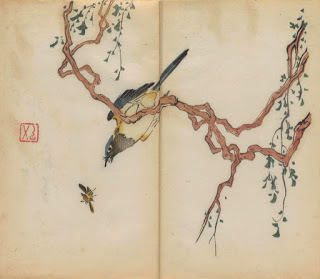 Cambridge University Library digitises world’s first multicolour printed book
Cambridge University Library digitises world’s first multicolour printed bookThis is a spread from the world’s first multicolour printed book, a 17th Century artist manual that remained in print for over 200 years. The Manual of Calligraphy and Painting (Shi zhu zhai shu hua pu) was created in 1633 by the Ten Bamboo Studio, using a technique called polychrome xylography, invented by the studio's owner, the pioneering artist and printmaker Hu Zhengyan. The earliest and the finest example of multicolour printing anywhere in the world, comprising 138 paintings and sketches with associated texts by 50 different artists and calligraphers, the physical copy of the book is so fragile that it was never opened before the Cambridge University Library decided to digitise it. Making each image involved several printing blocks with different coloured ink, though the end result looks like hand-painted watercolor images. That effect was very cutting-edge at the time, as Hu was the first to use printing techniques that allowed for more delicate gradations of colour.
Published on August 21, 2015 04:45
August 20, 2015
The Spy Who Came in from the Cold
 The Spy Who Came in from the Cold is a 1963 Cold War spy novel by British author John le Carré. It has become famous for its portrayal of Western espionage methods as morally inconsistent with Western democracy and values. The novel received critical acclaim at the time of its publication and became an international best-seller; it was selected as one of the All-Time 100 Novels by Time magazine. In 2006, Publishers Weekly named it the "best spy novel of all-time”.
The Spy Who Came in from the Cold is a 1963 Cold War spy novel by British author John le Carré. It has become famous for its portrayal of Western espionage methods as morally inconsistent with Western democracy and values. The novel received critical acclaim at the time of its publication and became an international best-seller; it was selected as one of the All-Time 100 Novels by Time magazine. In 2006, Publishers Weekly named it the "best spy novel of all-time”.In 1965, Martin Ritt directed the cinematic adaptation The Spy Who Came in from the Cold, with Richard Burton as Alec Leamas.
More Here/
Published on August 20, 2015 06:13



